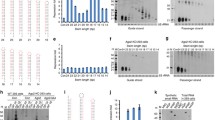Abstract
The intrinsic potency of a hairpin-based silencing trigger is one of the most critical determinants for applications such as the creation of stable knockdown cell lines or transgenic knockdown animals. To facilitate the creation of potent silencing constructs, we systematically investigated various parameters for their impact on the knockdown efficacy of hairpin-based RNAi shuttles. Results from our investigation clarified several misleading claims in the literature and defined a set of optimal parameters for hairpin-based RNAi shuttles. In this chapter, we will discuss various factors, such as scaffold (shRNA or miR30-based scaffold), configuration (length of stem and loop size), and target sequence selection, influencing the potency of silencing constructs and provide practical guidelines for designing effective hairpin-based RNAi shuttles.
Access this chapter
Tax calculation will be finalised at checkout
Purchases are for personal use only
Similar content being viewed by others
References
Brummelkamp TR, Bernards R, Agami R. A system for stable expression of short interfering RNAs in mammalian cells. Science 2002;296(5567):550 –3.
Brummelkamp TR, Bernards R, Agami R. Stable suppression of tumorigenicity by virus-mediated RNA interference. Cancer Cell 2002;2(3):243–7.
Gupta S, Schoer RA, Egan JE, Hannon GJ, Mittal V. Inducible, reversible, and stable RNA interference in mammalian cells. Proc Natl Acad Sci U S A 2004;101(7):1927–32.
Hemann MT, Fridman JS, Zilfou JT, et al. An epi-allelic series of p53 hypomorphs created by stable RNAi produces distinct tumor phenotypes in vivo. Nat Genet 2003;33(3):396 –400.
Lee NS, Dohjima T, Bauer G, et al. Expression of small interfering RNAs targeted against HIV-1 rev transcripts in human cells. Nat Biotechnol 2002;20(5):500–5.
Miyagishi M, Taira K. U6 promoter-driven siRNAs with four uridine 3′ overhangs efficiently suppress targeted gene expression in mammalian cells. Nat Biotechnol 2002;20(5):497–500.
Paddison PJ, Caudy AA, Bernstein E, Hannon GJ, Conklin DS. Short hairpin RNAs (shRNAs) induce sequence-specific silencing in mammalian cells. Genes Dev 2002;16(8):948–58.
Rubinson DA, Dillon CP, Kwiatkowski AV, et al. A lentivirus-based system to functionally silence genes in primary mammalian cells, stem cells and transgenic mice by RNA interference. Nat Genet 2003;33(3):401–6.
Silva JM, Li MZ, Chang K, et al. Second-generation shRNA libraries covering the mouse and human genomes. Nat Genet 2005;37(11):1281–8.
Scherer LJ, Frank R, Rossi JJ. Optimization and characterization of tRNA-shRNA expression constructs. Nucleic Acids Res 2007;35(8):2620–8.
Siolas D, Lerner C, Burchard J, et al. Synthetic shRNAs as potent RNAi triggers. Nat Biotechnol 2005;23(2):227–31.
Xia H, Mao Q, Eliason SL, et al. RNAi suppresses polyglutamine-induced neurodegeneration in a model of spinocerebellar ataxia. Nat Med 2004;10(8):816–20.
Boudreau RL, Monteys AM, Davidson BL. Minimizing variables among hairpin-based RNAi vectors reveals the potency of shRNAs. RNA 2008;14(9):1834– 44.
Lin X, Yang J, Chen J, Gunasekera A, Fesik SW, Shen Y. Development of a tightly regulated U6 promoter for shRNA expression. FEBS Lett 2004;577(3):376–80.
Liu YP, Haasnoot J, Berkhout B. Design of extended short hairpin RNAs for HIV-1 inhibition. Nucleic Acids Res 2007;35(17):5683–93.
Chung KH, Hart CC, Al-Bassam S, et al. Polycistronic RNA polymerase II expression vectors for RNA interference based on BIC/miR-155. Nucleic Acids Res 2006;34(7):e53.
Henry SD, van der Wegen P, Metselaar HJ, Tilanus HW, Scholte BJ, van der Laan LJ. Simultaneous targeting of HCV replication and viral binding with a single lentiviral vector containing multiple RNA interference expression cassettes. Mol Ther 2006;14(4):485–93.
Li L, Lin X, Khvorova A, Fesik SW, and Shen Y. Defining the optimal parameters for hairpin-based knockdown constructs. RNA 2007; 13(10):1765–1774.
Author information
Authors and Affiliations
Corresponding author
Editor information
Editors and Affiliations
Rights and permissions
Copyright information
© 2011 Springer Science+Business Media, LLC
About this protocol
Cite this protocol
Shen, Y. (2011). Designing Hairpin-Based RNAi Shuttles. In: Harper, S. (eds) RNA Interference Techniques. Neuromethods, vol 58. Humana Press. https://doi.org/10.1007/978-1-61779-114-7_1
Download citation
DOI: https://doi.org/10.1007/978-1-61779-114-7_1
Published:
Publisher Name: Humana Press
Print ISBN: 978-1-61779-113-0
Online ISBN: 978-1-61779-114-7
eBook Packages: Springer Protocols




